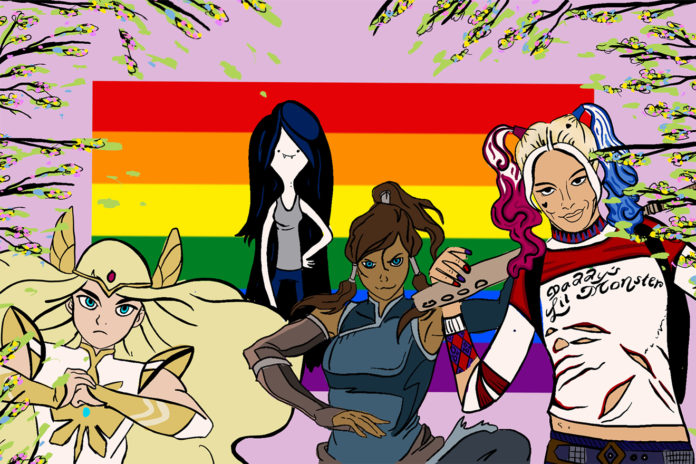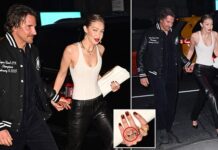
How do you describe something that you feel within yourself but are scared to look at? This feeling that you can poke and prod while understanding that examination would lead to rumination would lead to turning your whole life upside down? Fleeting thoughts percolate on the banks of memory and pull little by little; the silt builds and builds until it can’t be ignored. I’m sure I’m not the only one who has felt this way, as the past year of quarantine provided everyone with ample opportunities to self-reflect and face issues that had long been on the back burner.
The pandemic also allowed me to watch a lot of television — specifically, a lot of cartoons. Since January 2020, I have watched 14 animated TV shows and about 30 movies (including the entire Studio Ghibli catalog). Something about the medium of animation captured my attention and provided stability for me throughout an unstable, unprecedented year. When I commit, I commit hard: My most recent binge-watch was all 274 episodes of the acclaimed Cartoon Network epic “Adventure Time.”
Now you may be thinking, what’s the math? Why is this adult writer talking to me about something I watched in fifth grade and promptly forgot about? I promise you it makes sense. Just tuck yourself in, snuggle under a freshly knitted blanket and allow me to regale you with a story about how cartoons helped me come to terms with myself. It’ll be mathematical and cuckoo banana pants, I promise.
It all comes back to that feeling, that discomfort of something not sitting right with your brain before you hide it away and hope it fades. That started for me around my freshman year of college. I started thinking of questions that challenged my heterosexuality, so naturally, I said “Nope!” and forgot about them for a while. Just like anything else, these questions resurfaced a year later with a vengeance and demanded my attention. Being a busy college student, I took my time answering them and never got around to a satisfactory response. How could I question my sexuality after living one way for 20 years? It was like waking up one day and questioning if gravity existed: absurd, stupid and obviously a silly waste of time.
As a distraction, I decided to do a rewatch of “Avatar: The Last Airbender,” which truly is as great as people say. When I ran out of those episodes around mid-February, I hopped into the more controversial sequel series, “The Legend of Korra,” and found myself enamored. These shows were my comfort food: well-written stories matched with gorgeous animation to create a feast for the eyes and brain. Both shows are worth the watch, yet what caught me off guard with “Korra” was the series finale’s implication that the female lead, the eponymous Korra, ended up not with her male love interest Mako, but her gal pal Asami. Something as small as two women holding hands on network TV (sadly, the best they could do in 2014) filled me with immense joy. And I didn’t know what to do about it.
So, I ignored it. I finished up my semester smiling on the outside and spiraling on the inside, unable to talk about my personal crisis because the world was on fire. So much was going on in those early months of 2020 that I felt guilty taking the time to think about myself. Then I watched “She-Ra and the Princesses of Power,” and my walls began to crumble. Silt was tumbling all around me, and with nowhere else to turn, I had to focus on it.
“She-Ra,” a Netflix reimagining of the popular Filmation series of the 1980s by showrunner Noelle Stevenson, is gay. There’s simply no other way to say it. The content of the show is fantastic — it’s a riveting adventure full of twists and turns and iconic characters — but that doesn’t stop it from being queer to the core. Adora is caught in a will they-won’t they relationship with her fre-nemisis Catra, Bow has two lovely gay librarian dads and Netossa and Spinerella are the lesbian “moms” of everyone’s dreams. That’s not even mentioning the pan/bisexuality of just about every single character or the groundbreaking non-binary representation of the shape-shifting, actor-for-hire Double Trouble.
Watching just after the fifth and final season aired, I followed the Best Friend Squad of Adora, Bow and Glimmer all around Etheria as they tried to stop the Horde. There’s something so refreshing about a show being so chock-full of queer characters but not making a big deal out of it: In Etheria, love is simply love. Full stop. I found that I related to nearly all of these characters (I’m a HUGE Catradora supporter), but I was particularly drawn to Double Trouble. There was something so enticing about being outside our standard gender binary, about choosing where you identify more one day over the next.
Starting “Steven Universe” right after finishing “She-Ra” (and forcing just about everyone I knew to watch it) affirmed one thing: Queer stories made me feel at home. There was something so comfortable about the openness and unabashed love they had for queer characters. They weren’t a token, an exaggeration or a two-second kiss that could be cut for the international release — these sapphic, bi, non-binary, gay and aromantic/asexual characters were whole people.
It was now June, three months into my journey of self-discovery, and though I was more comfortable with the idea of my changing identity, I had no solid ground to stand on yet. There were no labels I felt comfortable identifying with since the ideas were so nebulous and dynamic. During Pride month, I didn’t feel like I could join in because I had no idea where to slot myself into the community. It was lonely. Thankfully, cartoons came to my rescue once again.
Episode 37 of the first season of “Steven Universe” is called “Alone Together.” In it, Steven fuses with his friend Connie to form a singular person stuck smack dab in the middle of being masculine or feminine. When they show off their fused form (named Stevonnie) to the Crystal Gems, Pearl sees it as unnatural, Amethyst compliments them and Garnett walks up to them and says, “You’re not two people and you’re not one person. You are an experience. Make sure you’re a good experience.” To Garnett, it doesn’t matter who Stevonnie is, it matters that they enjoy being.
I paused the episode and took that in. I didn’t need to know how to make a sandcastle out of the silt yet; I could simply enjoy being around it. Labels are well and good, but it’s also more than okay to exist liminally, to be between labels as you take time discovering which one fits you best. I was content not knowing.
Cartoons allow for the abstraction of complicated concepts like death, love and gender. They have to so that they can get past the harsh censorship of Cartoon Network, Disney and Nickelodeon executives. But this abstraction also more accurately portrays the queer experience. For most people, myself included, the process of coming to terms with one’s queerness is not a straight line. The journey is bumpy and twisty and confusing, but abstractions can act as a homing beacon to help us find our way back. Even if everyone’s journey is different, we still understand the important aspects that connect us, and there’s no better medium to express that than cartoons.
It wasn’t until August when I was watching the underrated and thankfully queer “Harley Quinn” that I came out to someone. Even then, I didn’t have all the answers about what I wanted to be called or who I wanted to love, but I was okay not knowing at that moment. I was thankful to have someone who, even if he didn’t understand me, heard me. And that was enough.
If I’m being honest, I don’t even have all the answers now, just about a year after my self-examination started. That’s okay. The journey doesn’t really end, so it’s a good thing I’ve got plenty of diverse cartoons to watch in the meantime.
Digital Culture Beat Editor M. Deitz can be reached at mdeitz@umich.edu.









